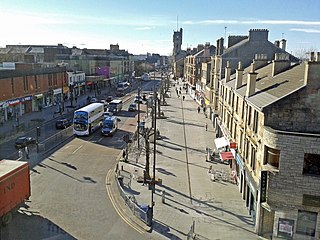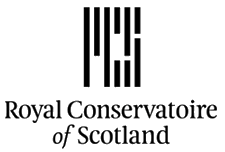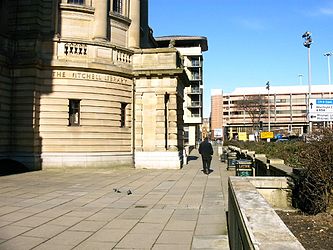
Rutherglen is a town in South Lanarkshire, Scotland, immediately south-east of the city of Glasgow, three miles from its centre and directly south of the River Clyde. Having previously existed as a separate Lanarkshire burgh, in 1975 Rutherglen lost its own local council and administratively became a component of the City of Glasgow District within the Strathclyde region. In 1996 the towns were reallocated to the South Lanarkshire council area.

George Square is the principal civic square in the city of Glasgow, Scotland. It is one of six squares in the city centre, the others being Cathedral Square, St Andrew's Square, St Enoch Square, Royal Exchange Square, and Blythswood Square on Blythswood Hill.

Pollokshaws is an area on the South side of the city of Glasgow, Scotland. It is bordered by the residential neighbourhoods of Auldhouse to the east, Eastwood and Hillpark to the south and Shawlands to the north, with the Glasgow South Western Line railway and the open lands of Pollok Country Park to the west. The White Cart Water flows through the area.

Buchanan Street is one of the main shopping thoroughfares in Glasgow, the largest city in Scotland. It forms the central stretch of Glasgow's famous shopping district with a generally more upmarket range of shops than the neighbouring streets: Argyle Street, and Sauchiehall Street.

The Royal Conservatoire of Scotland, formerly the Royal Scottish Academy of Music and Drama is a conservatoire of dance, drama, music, production, and film in Glasgow, Scotland. It is a member of the Federation of Drama Schools.

The State Library of New South Wales, part of which is known as the Mitchell Library, is a large heritage-listed special collections, reference and research library open to the public and is one of the oldest libraries in Australia. Established in 1869 its collections date back to the Australian Subscription Library established in the colony of New South Wales in 1826. The library is located on the corner of Macquarie Street and Shakespeare Place, in the Sydney central business district adjacent to the Domain and the Royal Botanic Gardens, in the City of Sydney. The library is a member of the National and State Libraries Australia (NSLA) consortium.

This article is intended to show a timeline of the history of Glasgow, Scotland, up to the present day.

Glasgow University Library in Scotland is one of the oldest and largest university libraries in Europe. At the turn of the 21st century, the main library building itself held 1,347,000 catalogued print books, and 53,300 journals. In total, the university library system including branch libraries now holds approximately 2.5 million books and journals, along with access to 1,853,000 e-books, and over 50,000 e-journals. The University also holds extensive archival material in a separate building. This includes the Scottish Business Archive, which alone amounts to 6.2 kilometres of manuscripts.

Easterhouse is a suburb of Glasgow, Scotland, 6 miles (10 km) east of the city centre on land gained from the county of Lanarkshire as part of an expansion of Glasgow before the Second World War. The area is on high ground north of the River Clyde and south of the River Kelvin and Campsie Fells.

Oatlands is an area in the city of Glasgow, Scotland. It is situated south of the River Clyde, falls within the Southside Central ward under Glasgow City Council, and is part of the Gorbals historic area. Its boundaries are Hutchesontown and the Southern Necropolis cemetery to the west, Polmadie to the south, Shawfield to the east, and Glasgow Green public park to the north.
Stephen Mitchell & Sons was a Scottish tobacco manufacturing company, established in Linlithgow in 1723. Mitchell is regarded as one of the earliest and the most significant player in Scottish tobacco production.
The Metropole Theatre started as the Scotia and was built in 1862 at 116, Stockwell Street, Glasgow, Scotland. Built to the designs of architect Robert Black for James Baylis, who later built the Theatre Royal in the Cowcaddens area of the city, it opened as the Scotia Hall, holding over 3000 people, with stalls and two galleries, reputed to be the first purpose built commercial music-hall in Scotland. Due to fire in 1875 it was rebuilt to the designs of architects Campbell Douglas and James Sellars and renamed The Scotia Variety Theatre, claiming to be the largest and best variety company in Scotland.
St Andrew's Cross, also known as Eglinton Toll, is a road junction in the south side of the city of Glasgow, Scotland. First constructed during the early 1800s, the junction formerly held several buildings including a power station and cinema, but have been removed for a variety of reasons. Since 1946 when the junction underwent a realignment, the two roads no longer intersect.

William Euing FRSE FSA was a Scottish philanthropist who left over 12,000 books to the University of Glasgow creating what is known as the Euing Collection. As an insurance broker he was founder of the Glasgow firm of William Euing & Co. He was President of the Glasgow Archaeological Society.

The Sydney School of Arts building, now the Arthouse Hotel, is a heritage-listed meeting place, restaurant and bar, and former mechanics' institute, located at 275–277a Pitt Street in the Sydney central business district in the City of Sydney local government area of New South Wales, Australia. It was designed by John Verge and built from 1830 to 1861. It is also known as Sydney Mechanics' School of Arts. It was added to the New South Wales State Heritage Register on 2 April 1999.

Sandyford is an area of Glasgow, Scotland. It is north of the River Clyde and forms part of the western periphery of the city centre. Formerly the name of a ward under Glasgow Town Council in the first part of the 20th century, it is within a continuous area of fairly dense urban development bordering several other neighbourhoods whose mutual boundaries have blurred over time, and is possibly less well known than all of the places which adjoin it, particularly Anderston and Finnieston.

Francis Thornton Barrett, LL.D., was the first Librarian of The Mitchell Library in Glasgow, Lanarkshire. As City Librarian, he initiated and developed public libraries throughout the city. He was also a founding member, and the first President, of the Scottish Library Association.
Septimus Albert Pitt was the second City Librarian of Glasgow, Lanarkshire, where he greatly extended the library services.
Stephen Mitchell was a Scottish tobacco manufacturer and philanthropist. He was the founder of the Mitchell Library, in Glasgow, Lanarkshire, Scotland, one of the earliest public reference libraries in Europe. Succeeding his father in business, Mitchell was Director of Stephen Mitchell & Son for approximately 38 years, and was a significant figure in 19th-century tobacco manufacturing, then one of the largest industries in the West of Scotland.




















